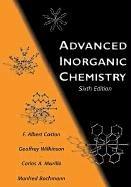| Listing 1 - 4 of 4 |
Sort by
|

ISBN: 0471199575 9780471199571 Year: 1999 Publisher: New York, N.Y. Wiley
Abstract | Keywords | Export | Availability | Bookmark
 Loading...
Loading...Choose an application
- Reference Manager
- EndNote
- RefWorks (Direct export to RefWorks)
For more than a quarter century, Cotton and Wilkinson's Advanced Inorganic Chemistry has been the source that students and professional chemists have turned to for the background needed to understand current research literature in inorganic chemistry and aspects of organometallic chemistry. Like its predecessors, this updated Sixth Edition is organized around the periodic table of elements and provides a systematic treatment of the chemistry of all chemical elements and their compounds. It incorporates important recent developments with an emphasis on advances in the interpretation of structure, bonding, and reactivity.From the reviews of the Fifth Edition:* "The first place to go when seeking general information about the chemistry of a particular element, especially when up-to-date, authoritative information is desired." -Journal of the American Chemical Society.* "Every student with a serious interest in inorganic chemistry should have [this book]." -Journal of Chemical Education.* "A mine of information . . . an invaluable guide." -Nature.* "The standard by which all other inorganic chemistry books are judged."-Nouveau Journal de Chimie.* "A masterly overview of the chemistry of the elements."-The Times of London Higher Education Supplement.* "A bonanza of information on important results and developments which could otherwise easily be overlooked in the general deluge of publications." -Angewandte Chemie.
Inorganic chemistry --- Chemistry, Inorganic. --- 546 --- Chemistry, Inorganic --- #WSCH:AAS1 --- anorganische chemie --- organometalische verbindingen --- Chemistry --- Inorganic compounds --- Atomic structure --- Chemical bonding --- Electronic structure --- Electrostatic structure --- Ionic compounds --- Ionic solids --- Ionic structure --- Nontransition element chemistry --- Stereochemistry --- Transition element chemistry --- Atomic structure. --- Chemical bonding. --- Electronic structure. --- Electrostatic structure. --- Ionic compounds. --- Ionic solids. --- Ionic structure. --- Nontransition element chemistry. --- Stereochemistry. --- Transition element chemistry. --- 546 Inorganic chemistry

ISBN: 0387258299 0387250840 9781281787347 1281787345 Year: 2005 Publisher: New York : Springer Science and Business Media, Inc.,
Abstract | Keywords | Export | Availability | Bookmark
 Loading...
Loading...Choose an application
- Reference Manager
- EndNote
- RefWorks (Direct export to RefWorks)
ince the second edition of this book there has been so much published in the ? eld that Stwo points seemed clear. One was a sense that a new, up-to-date monograph was needed. The other was the reluctance of two or even three people to undertake the daunting task of covering all the ground. Our response was to call on others to help and, thus, to produce the present, multiauthored volume. Each of the contributing authors was in a position to write - thoritatively, from hands-on research experience. We are con? dent that this has led to a better book than the three of us would have produced. As always in a book where different chapters are written by different authors, there is some variation in style and we chose not to try to smooth it all out. In every chapter the objective has been to be comprehensive, if not encyclopedic. Putting it a little differently, we, and the other authors, have aimed to mention all pertinent literature references, although the amount of emphasis accorded each paper necessarily varies. Since the volume of literature to cover is now so large, a few topics that might have been included (or were in the second edition) have been omitted or are covered only in limited detail.
Metal-metal bonds. --- Chemical bonds. --- Bonds, Chemical --- Chemical structure --- Chemistry, Physical and theoretical --- Overlap integral --- Quantum chemistry --- Valence (Theoretical chemistry) --- Metal-to-metal bonds --- Chemical bonds --- Chemistry, inorganic. --- Inorganic Chemistry. --- Inorganic chemistry --- Chemistry --- Inorganic compounds --- Inorganic chemistry.
Multi
ISBN: 9780387258294 Year: 2005 Publisher: Boston, MA Carlos A. Murillo
Abstract | Keywords | Export | Availability | Bookmark
 Loading...
Loading...Choose an application
- Reference Manager
- EndNote
- RefWorks (Direct export to RefWorks)
Book
ISBN: 9780387258294 Year: 2005 Publisher: Boston MA Springer US
Abstract | Keywords | Export | Availability | Bookmark
 Loading...
Loading...Choose an application
- Reference Manager
- EndNote
- RefWorks (Direct export to RefWorks)
ince the second edition of this book there has been so much published in the ? eld that Stwo points seemed clear. One was a sense that a new, up-to-date monograph was needed. The other was the reluctance of two or even three people to undertake the daunting task of covering all the ground. Our response was to call on others to help and, thus, to produce the present, multiauthored volume. Each of the contributing authors was in a position to write - thoritatively, from hands-on research experience. We are con? dent that this has led to a better book than the three of us would have produced. As always in a book where different chapters are written by different authors, there is some variation in style and we chose not to try to smooth it all out. In every chapter the objective has been to be comprehensive, if not encyclopedic. Putting it a little differently, we, and the other authors, have aimed to mention all pertinent literature references, although the amount of emphasis accorded each paper necessarily varies. Since the volume of literature to cover is now so large, a few topics that might have been included (or were in the second edition) have been omitted or are covered only in limited detail.
| Listing 1 - 4 of 4 |
Sort by
|

 Search
Search Feedback
Feedback About UniCat
About UniCat  Help
Help News
News